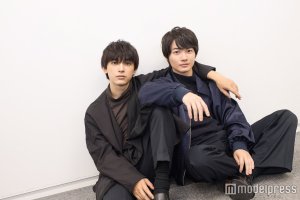Nagase is endearing as Killer K, but the uniform-clad Kamiki is the scene-stealer.
In this demonically divine musical comedy, "Motherf--ker!" almost becomes Japan’s national morale-booster "Ganbatte!" ("Do your best!") — so often is it hollered like a war-cry — yet judging by the guffaws it consistently elicits, the film’s outlandish, self-reflexive irreverence has struck the right chord. Helmer and writer Kankuro Kudo (Yaji and Kita: The Midnight Pilgrims) has managed to turn a simplistic tale of love and life choices into a thoroughly entertaining two-hour extravaganza through wacky allusions to rock music, absurd interpretations of Buddhist beliefs, and spots of well-placed humor.
The story is about a high school student Daisuke who has a crush on his classmate Hiromi . The bus they’re on crashes and Daisuke wakes up to find himself face-to-face with the swashbuckling demon Killer K in hell — Buddhist hell. Daisuke, with K’s help, embarks on a quest to leave Inferno, but expectedly, gets sidetracked — by K’s backstory and hellish bureaucracy.
There’s strong comedic chemistry between Killer K and Daisuke. K with his painted face, big hair and medieval-glam rock gowns is what happens when KISS crosses over with Kabuki theatre, and it’s brilliant. By contrast, Daisuke has the pale androgynous visage of a millennial. Nagase, a contemporary of 90s heart-throb Kimura Takuya, is endearing as Killer K, but the young uniform-clad Kamiki is the scene-stealer.
The music is definitely a highlight of the film, one which helps to make the sometimes random humor and repetitiveness palatable. Ranging from metal to blues, and always given a ‘feel-good’ rendition, the pieces come with witty commentary about the industry, like what happens if you play the guitar with arms borrowed from Jimmy Hendrix, Gary Moore and Randy Rhoads?
Heaven is portrayed as Japanese society on steroids. It’s a pristine futuristic expanse that bans sounds over 20 decibels, and two passive-aggressive guardians carry this out with the efficiency of a world-class metropolis. The one-stop remote has buttons for everything, including sex and suicide. Kudo’s experience in theatre is evident in the actors’ stylized movements and the minimalist sets. And it’s this inventive presentation, as well as snide comments about hell’s badassism, that saves the boring-paradise versus tantalizing-hell dichotomy from feeling like a big cliche.
The costumes and sets are a tad formulaic but then the film makes it clear that it thrives on kitsch. In fact Too Young to Die has enough quirk and kitsch to be cult, if it wasn’t for the clever humor.
The story is about a high school student Daisuke who has a crush on his classmate Hiromi . The bus they’re on crashes and Daisuke wakes up to find himself face-to-face with the swashbuckling demon Killer K in hell — Buddhist hell. Daisuke, with K’s help, embarks on a quest to leave Inferno, but expectedly, gets sidetracked — by K’s backstory and hellish bureaucracy.
There’s strong comedic chemistry between Killer K and Daisuke. K with his painted face, big hair and medieval-glam rock gowns is what happens when KISS crosses over with Kabuki theatre, and it’s brilliant. By contrast, Daisuke has the pale androgynous visage of a millennial. Nagase, a contemporary of 90s heart-throb Kimura Takuya, is endearing as Killer K, but the young uniform-clad Kamiki is the scene-stealer.
The music is definitely a highlight of the film, one which helps to make the sometimes random humor and repetitiveness palatable. Ranging from metal to blues, and always given a ‘feel-good’ rendition, the pieces come with witty commentary about the industry, like what happens if you play the guitar with arms borrowed from Jimmy Hendrix, Gary Moore and Randy Rhoads?
Heaven is portrayed as Japanese society on steroids. It’s a pristine futuristic expanse that bans sounds over 20 decibels, and two passive-aggressive guardians carry this out with the efficiency of a world-class metropolis. The one-stop remote has buttons for everything, including sex and suicide. Kudo’s experience in theatre is evident in the actors’ stylized movements and the minimalist sets. And it’s this inventive presentation, as well as snide comments about hell’s badassism, that saves the boring-paradise versus tantalizing-hell dichotomy from feeling like a big cliche.
The costumes and sets are a tad formulaic but then the film makes it clear that it thrives on kitsch. In fact Too Young to Die has enough quirk and kitsch to be cult, if it wasn’t for the clever humor.
Was this review helpful to you?





